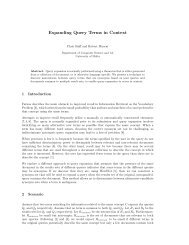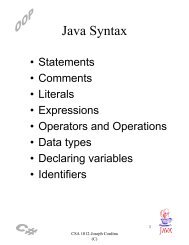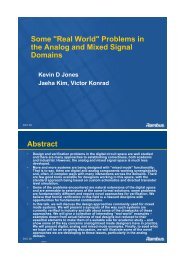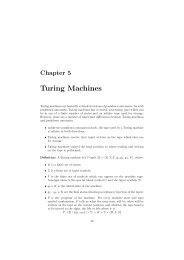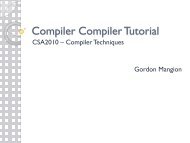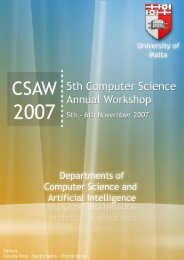Proceedings of CSAW'04 - FTP Directory Listing - University of Malta
Proceedings of CSAW'04 - FTP Directory Listing - University of Malta
Proceedings of CSAW'04 - FTP Directory Listing - University of Malta
You also want an ePaper? Increase the reach of your titles
YUMPU automatically turns print PDFs into web optimized ePapers that Google loves.
Forecasting Using Non-Linear Techniques In Time Series Analysis 27<br />
[21] These are some methods to calculate the degree <strong>of</strong> success <strong>of</strong> prediction, each <strong>of</strong> which contributes<br />
in a different manner to the evaluation <strong>of</strong> the prediction: mean error, mean absolute error,<br />
sum <strong>of</strong> squared error, root mean square error, percentage error, mean percentage error (MPE),<br />
mean absolute percentage error (MAPE).<br />
Measurement <strong>of</strong> prediction error is important to improve on the prediction process by helping to<br />
identify the sets <strong>of</strong> input parameters which gave the best prediction results.<br />
8 Number <strong>of</strong> Variables Used in Analysis<br />
[10] Univariate time series (measurement <strong>of</strong> one observable) has been considered so far. Phase space<br />
has been reconstructed using delay vectors based on combinations <strong>of</strong> these measurements. However<br />
it is possible to form an embedding using a set <strong>of</strong> different variables obtained at the same time.<br />
One could think <strong>of</strong> other ways <strong>of</strong> representing the underlying system.<br />
Multichannel measurements is analysis using multiple sources <strong>of</strong> simultaneous data — several<br />
measurements <strong>of</strong> the same type — at the same time — but at different segments <strong>of</strong> the process —<br />
which may give a more complete representation <strong>of</strong> the underlying system<br />
Equivalent variables at different positions — In other situations one may find it useful to measure<br />
similar physical quantities simultaneously at different positions in a spatially extended system.<br />
Variables with different physical meanings - One may also want to measure several observables<br />
with different physical meanings simultaneously. E.g. a 9-dimensional space with three different<br />
observables each at three different times.<br />
Distributed systems multivariate time series are very frequent in physiology, economics or climatology,<br />
but are generally too complicated for a systematic investigation <strong>of</strong> the interrelation between<br />
the observables. There are research problems which are still unsolved. Take the example <strong>of</strong> a bivariate<br />
time series. There is a problem in deciding which observable to use in order to define the<br />
delay embedding based on one coordinate. Which observable yields more additional information<br />
9 Methodology<br />
Forecasting methods: A number <strong>of</strong> methods exist which help the analyst to develop a forecasting<br />
model with a degree <strong>of</strong> objectivity, in a way which is measurable and reproducible.<br />
These methods usually involve:<br />
– the preparation <strong>of</strong> the data for analysis — smoothing, identification <strong>of</strong> cyclic (seasonal) components,<br />
trends, outliers, noise reduction;<br />
– the application <strong>of</strong> a selected technique or set <strong>of</strong> techniques;<br />
– measurement <strong>of</strong> forecasting error;<br />
– refinement <strong>of</strong> parameters <strong>of</strong> model;<br />
– updating <strong>of</strong> time series data as the current data becomes out <strong>of</strong> date;<br />
– repeated evaluation <strong>of</strong> accuracy <strong>of</strong> model and refinement <strong>of</strong> model.<br />
Standards and Practices for forecasting: [17] A set <strong>of</strong> standards is proposed by Scott Armstrong.<br />
From a detailed study in the use <strong>of</strong> standards a model with 139 points falling under these 16<br />
categories was formulated, covering formulating problems, obtaining information, implementing<br />
methods, evaluating methods and using forecasts.



